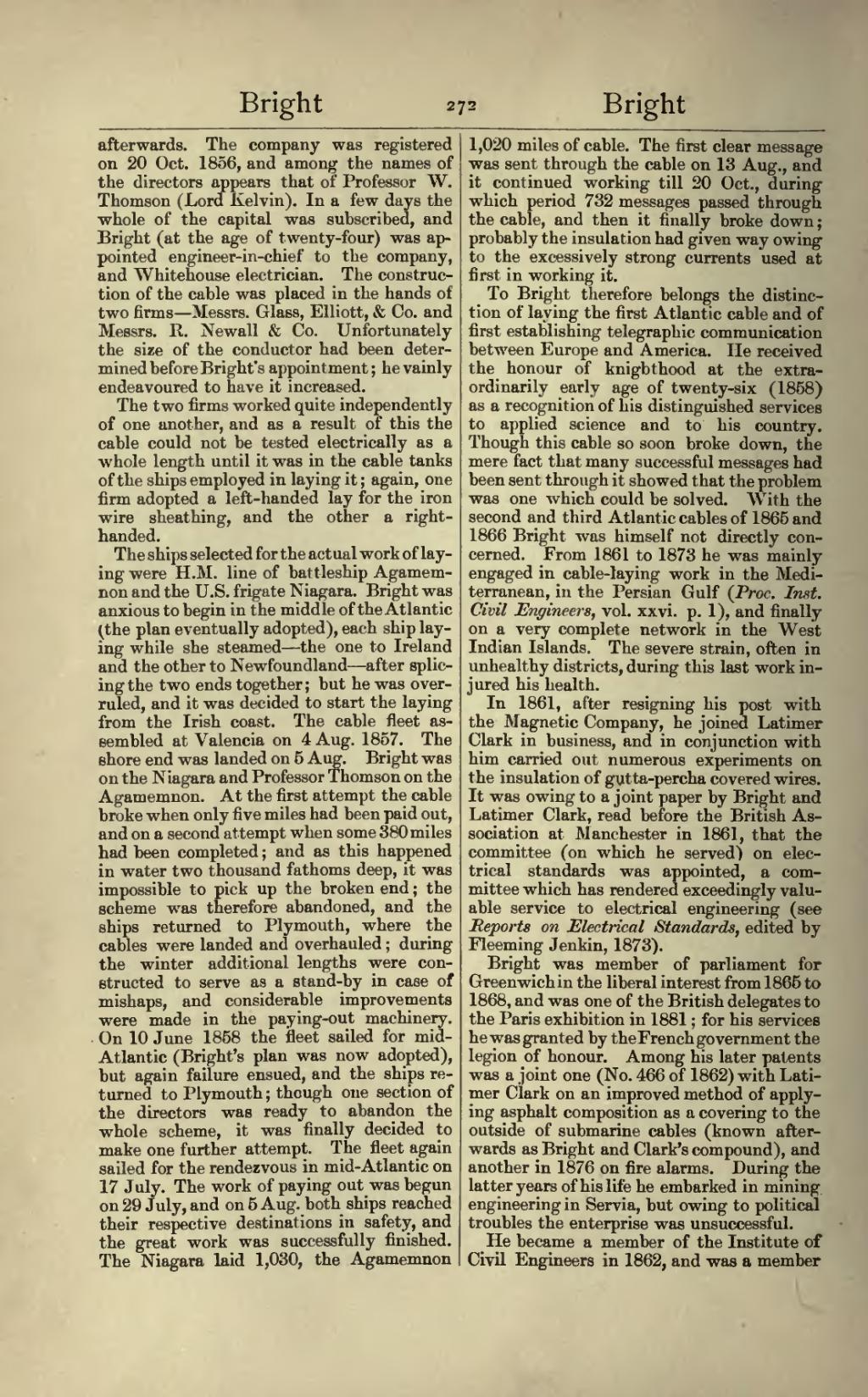afterwards. The company was registered on 20 Oct. 1856, and among the names of the directors appears that of Professor W. Thomson (Lord Kelvin). In a few days the whole of the capital was subscribed, and Bright (at the age of twenty-four) was appointed engineer-in-chief to the company, and Whitehouse electrician. The construction of the cable was placed in the hands of two firms — Messrs. Glass, Elliott, & Co. and Messrs. R. Newall & Co. Unfortunately the size of the conductor had been determined before Bright's appointment ; he vainly endeavoured to have it increased.
The two firms worked quite independently of one another, and as a result of this the cable could not be tested electrically as a whole length until it was in the cable tanks of the ships employed in laying it ; again, one firm adopted a left-handed lay for the iron wire sheathing, and the other a right-handed.
The ships selected for the actual work of laying were H.M. line of battleship Agamemnon and the U.S. frigate Niagara. Bright was anxious to begin in the middle of the Atlantic (the plan eventually adopted), each ship laying while she steamed — the one to Ireland and the other to Newfoundland — after splicing the two ends together; but he was overruled, and it was decided to start the laying from the Irish coast. The cable fleet assembled at Valencia on 4 Aug. 1857. The shore end was landed on 5 Aug. Bright was on the Niagara and Professor Thomson on the Agamemnon. At the first attempt the cable broke when only five miles had been paid out, and on a second attempt when some 380 miles had been completed ; and as this happened in water two thousand fathoms deep, it was impossible to pick up the broken end ; the scheme was therefore abandoned, and the ships returned to Plymouth, where the cables were landed and overhauled ; during the winter additional lengths were constructed to serve as a stand-by in case of mishaps, and considerable improvements were made in the paying-out machinery. On 10 June 1858 the fleet sailed for mid-Atlantic (Bright's plan was now adopted), but again failure ensued, and the ships returned to Plymouth ; though one section of the directors was ready to abandon the whole scheme, it was finally decided to make one further attempt. The fleet again sailed for the rendezvous in mid- Atlantic on 17 July. The work of paying out was begun on 29 July, and on 5 Aug. both ships reached their respective destinations in safety, and the great work was successfully finished. The Niagara laid 1,030, the Agamemnon 1,020 miles of cable. The first clear message was sent through the cable on 13 Aug., and it continued working till 20 Oct., during which period 732 messages passed through the cable, and then it finally broke down ; probably the insulation had given way owing to the excessively strong currents used at first in working it.
To Bright therefore belongs the distinction of laying the first Atlantic cable and of first establishing telegraphic communication between Europe and America. He received the honour of knighthood at the extraordinarily early age of twenty-six (1858) as a recognition of his distinguished services to applied science and to his country. Though this cable so soon broke down, the mere fact that many successful messages had been sent through it showed that the problem was one which could be solved. With the second and third Atlantic cables of 1866 and 1866 Bright was himself not directly concerned. From 1861 to 1873 he was mainly engaged in cable-laying work in the Mediterranean, in the Persian Gulf (Proc. Inst. Civil Engineers, vol. xxvi. p. 1), and finally on a very complete network in the West Indian Islands. The severe strain, often in unhealthy districts, during this last work injured his health.
In 1861, after resigning his post with the Magnetic Company, he joined Latimer Clark in business, and in conjunction with him carried out numerous experiments on the insulation of gutta-percha covered wires. It was owing to a joint paper by Bright and Latimer Clark, read before the British Association at Manchester in 1861, that the committee (on which he served) on electrical standards was appointed, a committee which has rendered exceedingly valuable service to electrical engineering (see Reports on Electrical Standards, edited by Fleeming Jenkin, 1873).
Bright was member of parliament for Greenwich in the liberal interest from 1865 to 1868, and was one of the British delegates to the Paris exhibition in 1881 ; for his services he was granted by the French government the legion of honour. Among his later patents was a joint one (No. 466 of 1862) with Latimer Clark on an improved method of applying asphalt composition as a covering to the outside of submarine cables (known afterwards as Bright and Clark's compound), and another in 1876 on fire alarms. During the latter years of his life he embarked in mining engineering in Servia, but owing to political troubles the enterprise was unsuccessful.
He became a member of the Institute of Civil Engineers in 1862, and was a member
